Vapor lock solutions
Comments
-
My methods are probably not going to be met with much more than skepticism, but about 18 months ago I had an epiphany of sorts, and it all had to do with vapor lock and overheating old cars.I was sick to DEATH of fighting those two issues to the point that it not only took the fun out of driving my old cars, but I had come to the conclusion that if I could not solve the issues, I wasn't going to HAVE old cars. I was going to finish the convertible and sell it and do the same with the sedan (maybe, if Vicki would have allowed it, as that's really her car) and be done with the whole mess.I went through the gamut of re-coreing the radiator and installing bypasses, and adding electric fans, and wrapping lines with anti-heat material and running return fuel lines and on and on and on ad nausem. Still makes me sick thinking about it . . . I HATED all of that nonsense and all seemed like a bunch of band-aids and like I was going about the situation all wrong.In fact, I was. All of those fixes were fighting the EFFECTS of the problem and not the CAUSE. I wanted to fight the cause at the source. The source of all of the issues is modern day fuel. The 10% ethanol GARBAGE gas that we get out of the pump. Really, if you think about it, there's only two things that have changed about our cars (not counting the aging process) from right now to the way it was in the first half of the 20th century. Those two things are, our oil and our gas. Our oil has improved, the gas has not. Speaking of which, am I an engineer? No. Am I an automotive designer? No. Electrical engineer? Hardly. I'm just a shadetree with a great passion for Hudsons who spent a lot of time and effort talking to people who know more than me and making some very logical deductions in the process.The Solution is really quite simple! Go to your local airport and purchase aviation fuel and run that in your car. Your car will love it and it will run like a top!! Guaranteed. Now if you don't mind the $5-$6 a gallon that you will have to pay, you're in business!Unfortunately, I didn't want to do that. I wanted to make my cars run GREAT on Bad Gas. It took a lot of research and some experimentation but I came up with a solution that makes my cars perform like they are supposed to, never overheat and never have vapor lock issues. I am not going to go into the WHY these fixes work on this forum, but I will be happy to sit down and explain my conclusions to anyone that wants to take the time to do it. I assure you, there is a logical answer to all of my "fixes".All of the fixes have to do with the way your car distributes it's fuel and what kind of spark you put to your cylinders. Here are the changes I came up with:Dump the 6V system, at least to the point of running 12V to your engineGap spark plugs at .032Run high quality shielded spark plug wiresGet rid of the points and install HEI or electronic ignition (can be done inside your stock distributor)Install a 40,000 volt coil (looks just like a stock coil)Re-jet your carburetor .001-.002 larger depending on your applicationRun a return fuel lineThere are a few other things that can be helpful, but are not completely necessary. Running a 3-core radiator over a 2-core or a 4-core over a stock 3-core is beneficial, as is a shroud, or a helper fan. Putting an additive in your gas tank is helpful (like Marvel). Putting wetting agents and anti-rust agents and running primarily coolant in your radiator (as opposed to water) is helpful. Many other things can be helpful, as well.Now, making these changes in a car that is not very well maintained, or has a clogged distribution tube is NOT going to help you. A well-maintained, properly functioning system is must to start with, as it is with any modifications. Nothing new here.What has this done for me? I have two Hudsons, both '52's, both 308's. One stock, one heavily modified. BOTH cars have had the changes above completed.My sedan, which also has AC thrown into the mix, runs at 157-162-degrees all day long in 100+ degree weather . . . with the AC blowing. It never overheats and never vapor locks. It runs like a top. That motor was rebuilt 25 years ago by Jack Clifford.The convertible (so far) has about 50 miles on it now. It runs on the highway at a steady 145-degrees at 75 mph. It runs so good, it physically makes me break out in goose-bumps. We're finishing up the AC tomorrow. This engine was built by Doug Wildrick and Jeff Perkins recently.I got what I wanted, I get to keep my cars and vapor lock and overheating automobiles are not part of my life.0
-
A comment I would make. People should NOT insulate the inside of the hood. Mine came with messed up foil/fiberglas so I had to recover to make look good. After running for 2 summers I believe some of the problem is getting the heat OUT of the engine compartment {like '40 Fords/ Austin Healeys, etc}. I have done a lot of things including insulation of the headers & twin exhaust (that I don't read a lot about).
Hard to find photos of the hood inside for me to find out if they had hood insulation when stock. The Gallery shows only about 2 engine photos and none of the hoods. Anyway, I sure don't run at 145 but at 75 I can run 160-170 with A/C on or off and I really think that is too cold. But around town in 3rd I hope to run 190.
Never had vapor lock on any car I've owned; I do all the recommended stuff, but not towing a trailer up a mountain either.0 -
Good points, Richard!I'll touch base with what I know about Hudsons and insulation. I believe Richard is correct, in that they are not letting heat OUT. I have found that there are very few design flaws in a stepdown, but one for sure, at least what has become one, is that the heat in a radiator rises to the top of the radiator. If you look at a stepdown closely, that's the part that really doesn't get any (or very little) air around it, thus trapping the heat inside. One thing that Walt has recommended is not putting the 'V'-shaped WTSP that goes on top of the shroud and meets up with the lip at the bottom of the hood edge. Not installing that piece allows some air to get between hood and grille and up around the top of the radiator, which helps a great deal.In searching for body parts for the convertible, I noticed that some hoods did not have a full hood blanket, but rather two small squares of felt-like material to go between hood and hood brace. These were on original hoods. I'll perpetuate a rumor in that i have heard that hood insulation was dealer installed, but have not been able to substantiate that. Regardless, I took those hoods I found with no sign of insulation as a cue and did the same on my car.
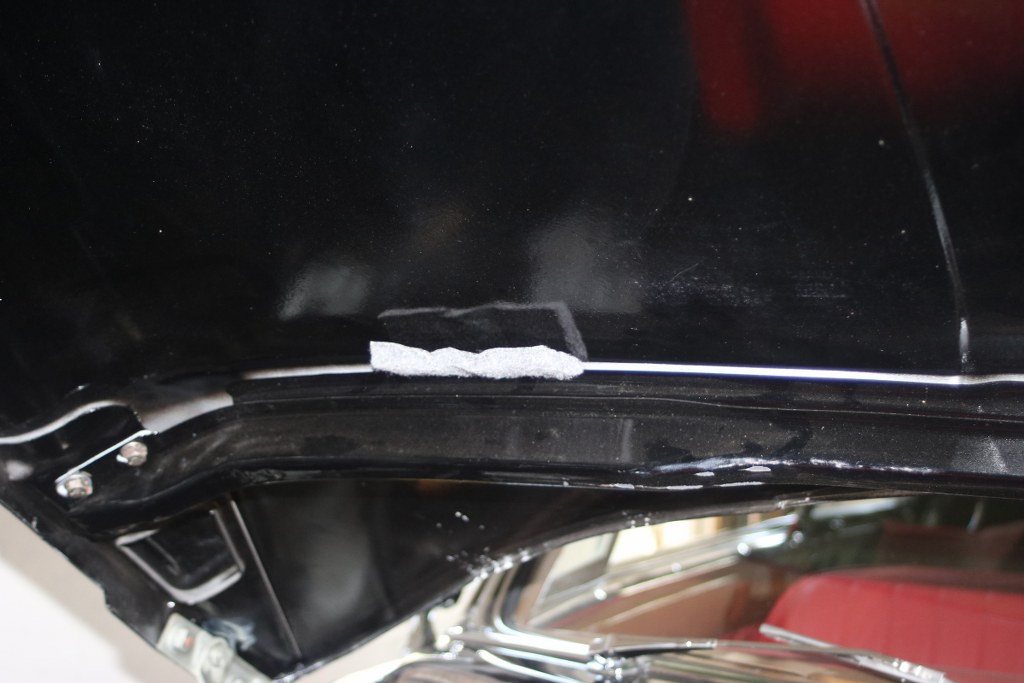
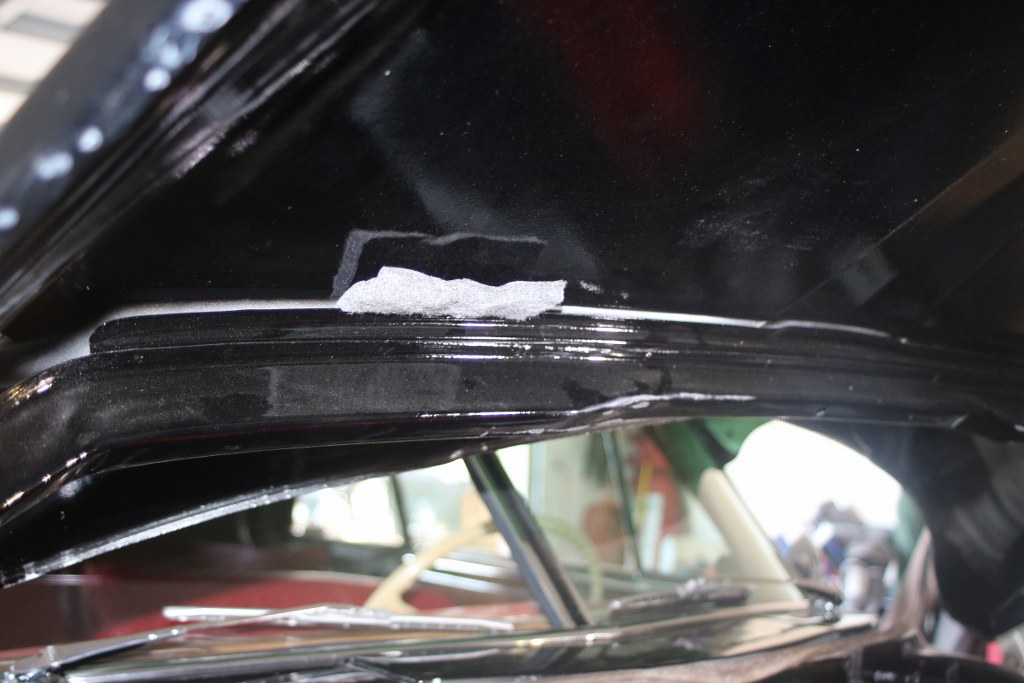 0
0 -
Don't know what 'WTSP' refers to {maybe I don't have it?} I just looked and didn't see anything. Will ask a question I have wondered about: has anyone made the chrome piece on the 53 functional; cutting slots in the hood and cutting out the 'black' paint parts of the ornament???? Never had it off so don't even know if that is possible but do know that it should be that way. Wish mine were like that !0
-
"WTSP" is short for weather-stripping. See pics below for the WTSP I was referring. (I haven't put mine on and I just might not, not sure. It also prevents the hood from scratching the plate and in turn scratching the lip on the hood.And yes! I have seen where someone cut out the black parts on a '53 hood ornament and then drilled round holes underneath in the hood. The car I saw it on was a red car . . . but can't remember whose it was. I'm sure others have done it as well.
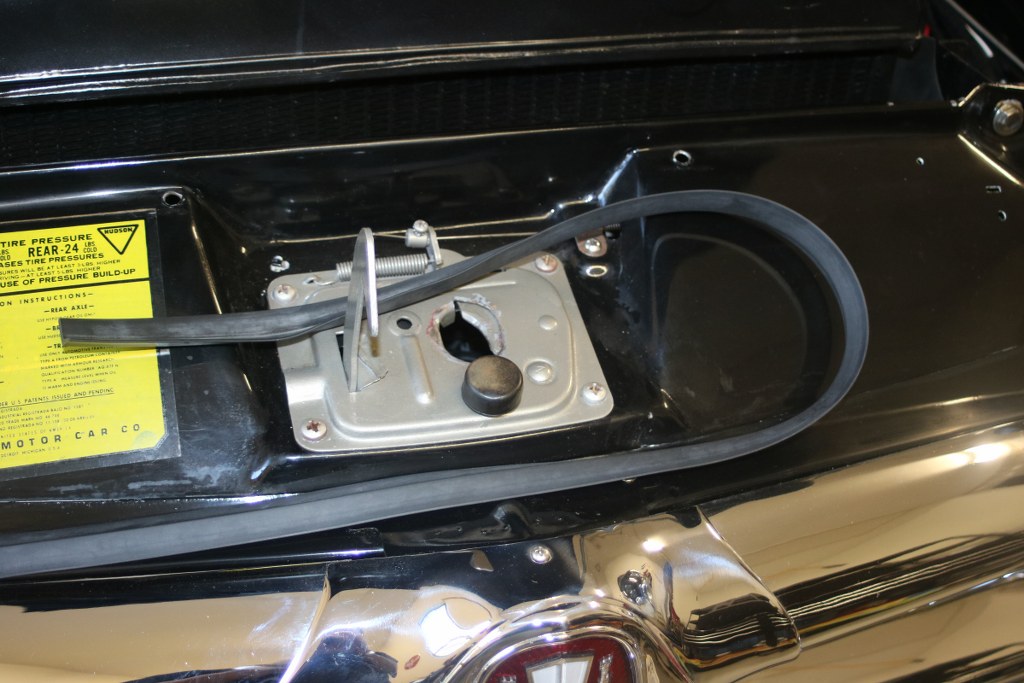
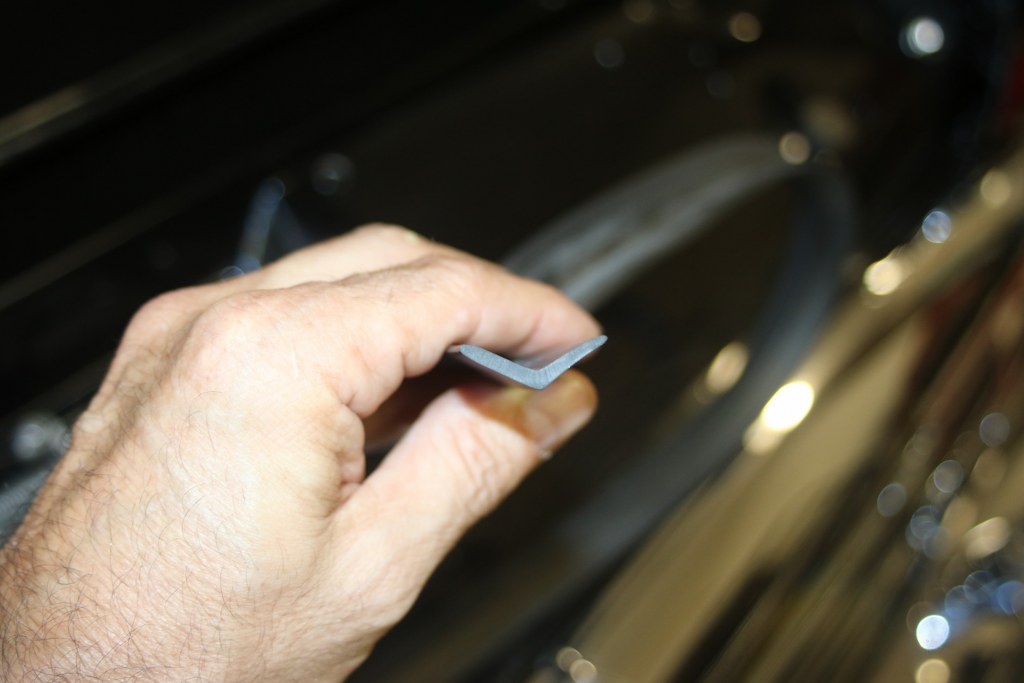 0
0 -
Strangely enough, that leads to some other Hudson over-engineering. See pic below. These holes in the plate behind the grille ornament are staple holes where that WTSP was stapled, which probably made it harder to change the bulb behind the ornament and defeated the purpose of not putting chips in your hood's paint on the lip!
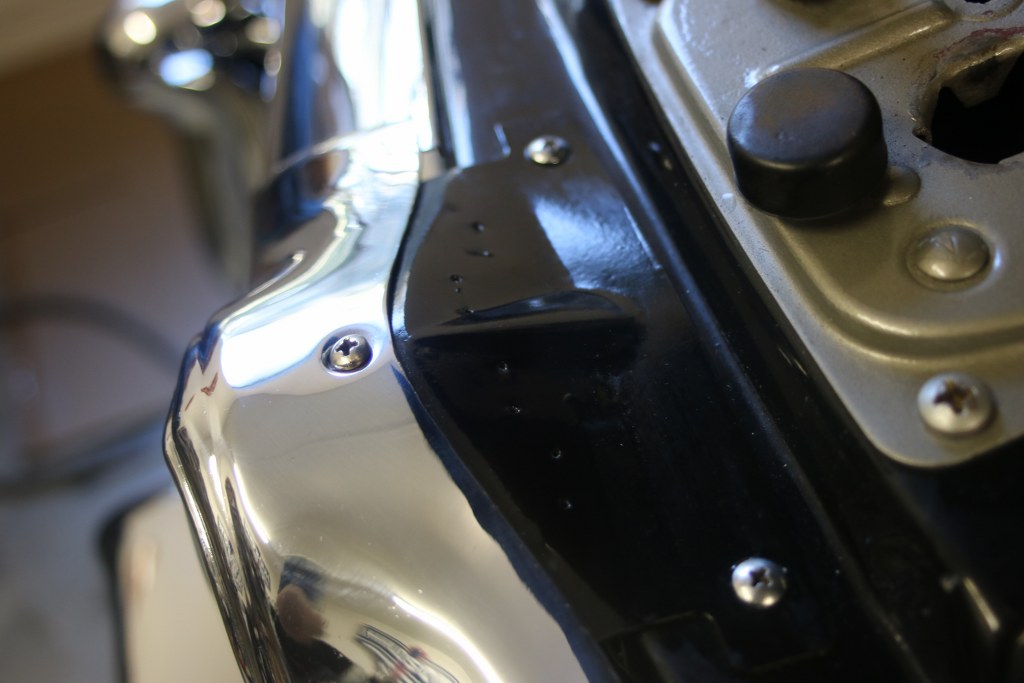 0
0 -
spot on what Russell says. I just have 1 difference, I am still 6 volt. However I am electronic ignition, with the coil that he suggests, 6 volt alternator, and 2 Optima Batteries in series. I got lucky and found a 4 core radiator. Runs at 170-180 temp with outside temp at 100 degrees. will sit at a 2 minute stoplight, and stay below half. 180 degree thermostat. Had the wrong spark plug wires for quite a few years, bitch to start. Electronic ignition people said you need new spark plug wires to match the coil.. Starts so easy I can't stand it.That's the wires that Russell mentions. Now lets go to the gas. Do not use regular, must use premium, or if you can afford aviation gas please do. You got to realize that there is corn in the gas. After time it reacts with some of the components in the carb. WATER.. Did with me. froze the jets inside the carb to the carb wall. That's another story, that led me to find out how to overhaul a carb myself. For years I said boy I can't touch that. In the pic you will see two add ons that I add to the gas. Now in the pic of the carb, you will see two bolts that when you loosen them and take the top of that part off the carb, you are now into the jets, that siphons the gas into the barrel. Every two months or so , I take that off very carefully as not to disturb the gasket, and heavily spray WD-40 all over those jets and try to get it down into the body of the carb. Replace top and go about your way. That and the STP keep things moving, and deters that water in the gas from attacking anything inside the carb. No I am not an engineer of any kind. Just a dumbhead dealing with a 1954 Hudson, in 2015. One thing I have found out though. If you drive for sometime at 60-70,and stop at a station to fill up, you will have a time trying to restart it. But some people don't. My friend has installed an electric fuel pump in his, and if it balks, he just presses the button and off she goes. of course he knows more about Hudson than I do. But an electric fuel pump is all solve way to go. Because on cold mornings you don't have to grind to get gas into the carb. Just push the button once, and off she goes. That's things we never had in1953. I can't remember ever having a problem starting the 51 Hornet coupe, when I had to be at the Post at Fort Sam Houston to stand roll call.7:00 AM But the gas was the answer. It fired those plugs. Cold weather or Hot weather. That car never balked on me. Have fun driving your Hudson. They are something else.!! One other help. Water Wetter in the Rad. So much for my sermon on the mount.
0 -
Thanks--I have never thought of running premium gasoline---believe I will from now on. Anyone else run premium ???0
-
Well, that was silly of me. Completely forgot to mention that I DO utilize a flow-through electric fuel pump just for the reasons Grandpa stated. That, along with the return fuel line, keeps the fuel moving and not sitting stagnant in a hot engine bay.Also, I'd like to mention that there is a new (new to me) product on the market that you put into your radiator and makes your car run 30-degrees cooler. I know several car collectors (some of which in excess of 50 cars) who are now putting it into all of their cars. The Product is made by Design Engineering, Inc. and the product is called Radiator Relief, Performance Radiator additive. Blue in color. Will look up a link . . .Here is what it looks like:I have not tested it yet, but the results come from some very respected sources. Most of the stories I have heard are from folks with old cars who are running in the 190-200 range (before the additive).0
-
The higher octane helps. Think about it. Back in the day, we used to be able to "Dial-a-octane" right on the pump. Up to 108, if I remember right. The old cars preferred that better gas which burned slower and had a high octane rating.Even up into the mid-80's, there was one place about 40 miles from my house that still had Ethyl out of the pump. I think the octane was 104. This was in the days after the lead disappeared, but no corn in the fuel. BOY, did my Olds run like a bat out of hell with that fuel in it. Had to be 20% more efficient and more powerful.Point is, the better quality fuel you have, the better your engine is going to run. Want a treat? Go get some aviation fuel and fill your tank and go have some fun. Exactly the same reason the moonshiners used to mix the alcohol off of the top end and the bottom end of the still with their fuel. 50/50, or so I've heard.0
-
Suppose you could advance the timing maybe 3-4 degrees by using high octane all the time { 91 not 93 }??0
-
I added Walt Mordenti's thermostat housing by pass seal off kit about 4 years ago that Walt says you get 95 per cent of the water back through the radiator, not 70 percent with the by-pass opened. After adding his kit, my overheating problem were eliminated.
I'll try the hi octane fuel. Up until last April I hadn't had a vapor lock problem. Now when I travel 50 freeway miles at 65-70 mph and when I get off freeway it is very hard to keep it running when at 35 mph and having to a stop for red light. If engine dies I have to wait a little to restart, then it runs fine again until I take another long freeway trip. Now I am in the process now of adding the 6 volt Pertronic electric ignition kit, Pertronic coil and electric fuel pump. I wonder if more than 10% alcohol is being added to gas now and not being told.
I appreciate all the suggestions that eliminate vapor lock problems.
Thank you.
Lee O'Dell0 -
I closed up my water bypass with a stainless freeze plug. Pressed (with a hammer) right in. Runs cooler. The 1954 Hudson engines do not have bypasses {as I remember}. Take outlet to parts place, they can size plug right there. No problem with warm up; don't drive in extremely cold weather anyway~~~
0 -
Thought of something: my air duct to the fuel pump.{and insulation wrap on exhaust header & gas line; and scoops to get more air to radiator}. Anything to cool this critter off, aye; helps with the thread title~~0
-
One rather simple "fix" -- I almost hate to mention it because you've probably done it already -- is to use a lot of spacers under the carb. I have four spacers, then the metal heat deflector -- then four more spacers. So many spacers, in fact, that I had to use a longer threaded stud to hold the carb to the manifold. But I haven't had vapor lock in years.
But then, I only have a measly little 212 c.i.d. engine....
0 -
Home run Jon. Actually the book calls for 5 top and bottom. I had the starvation issue with my 53 HH for years in the Az summers when temps hit about 92 and in traffic. I even tried running a electric pump as primary fuel delivery. Walts return line helped but only postponed the issue a few more degrees. What stopped the starvation was adding phenolic gaskets below the twin carbs. Fel Pro 60269 , one on top sandwiched between two paper gaskets, & one sandwiched on bottom between two paper gaskets. The fuel pump , an A/C dual diaphragm. was rebuilt at Then & Now and one gasket (spacer) was removed. Pump pressure = 5.5psi. Installed Bill Craigs Grose Jet float valves in the carbs. Also, moved the fuel line (pump to carb) 8 inches from the manifolds and slipped on a Mylar sleave on the steel line and another on the fuel line before the fuel pump... sold at Jeggs. All lines must be free of air leaks. A common problem is in the pickup tube in the tank. Make sure the gas cap is well vented. Cooling system needs to be in good shape. Hood insulations purpose was more for sound deadening then cooling. My car is a totally stock vehicle , and except for a primer electric pump Airtex 8011, is as the factory built it... even with Champion H11 plugs, and 6v.0
-
What about the narrow shroud that bolts on in front of the radiator at the top front?
I noticed in Russell's photo that it is missing. if left off that would allow a lot of air to be pushed past the very top of the radiator...or would it divert too much away from going straight through the radiator?
As for vapor lock, I've not had an issue with the Hudson, but on other old cars adding a little diesel fuel to the gas fixes it every time.
1 gallon to 20 gallons of gasoline.
Rob
0 -
Heres what Water Wetter looks like. Probably like the same stuff that Russell mentions.
And the shroud helps quite a bit from keeping the air escaping and directed towards the rad. Hard to see here but its there underneath the rad lip.
0 -
That piece only works with 6 cyl. engines. The radiator sits forward on an eight and the panel removed. I have seen several 6 cyl.cars that the piece is missing.Heres what Water Wetter looks like. Probably like the same stuff that Russell mentions.
And the shroud helps quite a bit from keeping the air escaping and directed towards the rad. Hard to see here but its there underneath the rad lip.
0 -
I use old wooden clothes pins like my mother used to use to keep laundry on the clothesline to dry. My dad used to put them on the gas line on his fifties model Buicks.... People always ask if they work and I tell them I haven't had a problem with vapor lock since I installed them.0
-
Here are my typical carb gaskets and as per consensus here, I am about 3 gaskets short on each carb ???
Think the big question is: How thick was the original 4 gaskets and how thick is the Fel-Pro one?
I haven't ever had vapor lock but who knows when?
These are available on Amazon Prime so I can get easily.
What is opinion??--a winter project {since new studs are needed}; Think I am OK tho.
left is front carb.; right is rear carb.
0 -
In Copenhagen, Denmark Henrik Maersk-Moller has the hair from a mop draped over the fuel pump of his 1935 Hudson 8. The lower part of this hair is in a tray mounted just below the fuel pump. When he goes for a drive on a hot day, he pours water over the mop hair and fills the tray with water. He says that this cured a problem with vapor lock he had previously.Per0
-
Per, I didn't think "Copenhagen" and "hot day" were ever used in the same sentence. When I was there it was hot at 20C and people were sunbaking. Not hot enough for vapour locks I wouldn't have thought but maybe the Hudson as acclimatised.0
-
You can buy ethanol remover at some parts stores. Comes in a bottle, forgot the name.0
-
0 -
Richard the gasket is 1/8" thick. I forgot to add something that Per reminded me about. In addition to the mylar sleeves on the fuel lines I fasten a mylar pad about 10" x 6" above the fuel pump below the exhaust manifold. This is important since it deflects heat away from the top of the pump, which will really cook due to the poor air flow in that area. The pad can be purchased at Jegs as well.
0 -
The narrow metal shroud that fits between the radiator and the hood latch/ fenders cross-tie piece is to prevent recirculation of the hot air through the top of the radiator. The fan pushes a large volume of hot air back toward the firewall, some goes down under the car, and some will be deflected upwards to the closed hood, and circulate back towards the low pressure zone in front of the radiator, meaning the hot air is recirculating through the radiator, and lessening cooling as much as 15% This can mean the engine running at 200F instead of 180F in traffic.
And just a note, mine was off in the picture because I was working in there, not because it doesn't normally reside there.0 -
Tks, Ron, {and congrats on the cover photo}. The ones I have are also 1/8" thick but if I put 4 on the bottom and 4 on the top the carbs would be 1/2" higher and would require longer studs than the factory installed??
You and I are together on the insulation; I also have the Jeggs slip-on gas line insulation and ALSO the piece of insulation on top of the fuel pump { and exhaust insulation} see in photos.
0 -
Ken,
Thanks for the explanation about the shroud.
Rob
0 -
Thanks. And yes Richard, I failed to disclose the stud length issue. 1/2 inch longer ones would be perfect.0
Categories
- 36.9K All Categories
- 112 Hudson 1916 - 1929
- 20 Upcoming Events
- 92 Essex Super 6
- 28.6K HUDSON
- 571 "How To" - Skills, mechanical and other wise
- 995 Street Rods
- 151 American Motors
- 178 The Flathead Forum
- 49 Manuals, etc,.
- 78 Hudson 8
- 44 FORUM - Instructions and Tips on using the forum
- 2.8K CLASSIFIEDS
- 608 Vehicles
- 2.1K Parts & Pieces
- 77 Literature & Memorabilia
- Hudson 1916 - 1929 Yahoo Groups Archived Photos





